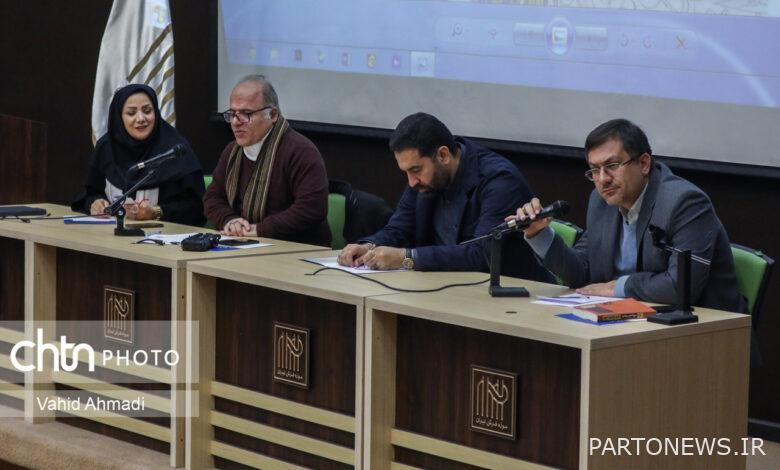The necessity of introducing the intangible heritage by the institutions/presenting Iran’s narratives and policies through the intangible heritage/the government should help to revive the barge building

According to the reporter of Arya Heritage, at the beginning of this meeting, Yazidi considered it necessary to increase the level of knowledge of cultural heritage in the society in order to protect, protect, revive and exploit the country’s cultural issues, and gave a speech in two parts related to the 2003 Convention and the performance of the Ministry in the field of World Registration of Intangible Heritage. .
Referring to the definition of intangible cultural heritage based on the definition of the 2003 UNESCO convention, he added: customs, shows, terms, knowledge and skills that are passed on to future generations and recreated throughout history also lead to the formation of a sense of identity and promote the diversity of human culture.
Director General of Registration of Works and Preservation and Revitalization of Spiritual and Natural Heritage by stating that untainted cultural heritage is included in three representative lists, in need of immediate safeguarding and good safeguarding measures, emphasized the importance of inter-departmental interactions and the activities of other institutions in the direction of education, introduction and use of capacities. He pointed out the intangible cultural heritage as an important concern and added: So far, 24 intangible cultural heritages of Iran have been registered in the world, of which 21 elements are in the representative list, two elements of replicas and boat-making are in the list of immediate conservation measures, and the art of calligraphy is in the list of good conservation measures.
Yazidi pointed to the recent global registration of the art of gilding, breaking the fast, and celebration of the century, and emphasized the need for the help and cooperation of the Ministry of Education and Culture, the Ministry of Islamic Culture and Guidance, and other cultural groups in order to introduce and not forget these elements, and added: The art of gilding Iran and it should be passed down from generation to generation. Raising a generation of talented artists who inherit this valuable art requires the support and cooperation of other institutions.
He also considered it important to point out the human values of Iftar in addition to its religious aspect and the century celebration as a culture from ancient Iran and to record these elements in the world.
The director general of the registration of works and the preservation and restoration of spiritual and natural heritage expressed his hope that the growing trend of the world registration of intangible heritage and the promotion from the fifth place in the world will resolve the concerns related to barge-making by the government and the continuation of this valuable art.
Using the soft power capacity of cultural heritage
In the continuation of this meeting, Atusa Momeni pointed out the use of the soft power capacity of intangible cultural heritage and added: Iran has always been the leader of peace, goodness and happiness for all ethnic groups, and cultural diversity and peaceful coexistence is one of the honors of this geography.
By stating that we are a nation with a history and an identity, he stated that the intangible cultural heritage, with regard to creating a balance between humans, resources and nature, has capacities in order to create an exchange of ideas and biological experience in the path of sustainable development and world peace.
The head of the Intangible Heritage Center considered the use of intangible cultural heritage as a suitable opportunity in cultural diplomacy, creating opportunities and improving the understanding of the culture of other countries and a guarantee for a sustainable livelihood economy, exchange of experience and greater social harmony through counting differences and achieving similarities.
Stating that cultural competition can be considered as a key competition in the world, Momeni continued: Cultural competition is the key to bring out all the experiences of humans throughout history and to achieve sustainable development of that society.
He pointed out the difference between cultural competition and other types of competition and added: Cultural competition does not mean surpassing and more profit, it only means trying to preserve and present it as a strategy to the world. The soft power of intangible cultural heritage can shape all our narratives and policies in the world.
Strengthening national identity through intangible heritage/global registration of elements that have networking capacity
Alireza Hassanzadeh named Aburihan Biruni as the first anthropologist in the world who was one of the pioneers of studying intangible cultural heritage.
Referring to the importance of solidarity as social capital, he emphasized the necessity of using intangible cultural heritage in strengthening national identity and portraying Iran’s culture and civilization.
The head of the Anthropology Research Institute continued: Intangible heritage has a great power in shaping the image of a nation, which should be taken into consideration in the country’s cultural policies. This issue should not be limited to the Ministry of Cultural Heritage, Tourism and Handicrafts and all the institutions should be placed together.
Saying that tourism economy has no meaning without heritage economy, Hasanzadeh added: If the building does not have intangible content and its narratives are forgotten, it will lose its meaningful aura.
He considered intangible heritage as a bridge between Iran and Iran’s cultural countries with cultural and civilizational commonalities and emphasized on using the capacity of elements that have networking capacity such as Tirgan, Summer Nowruz and Mehrgan. It is not, but it causes a sense of happiness, belonging and increasing social integration.
end of message/

